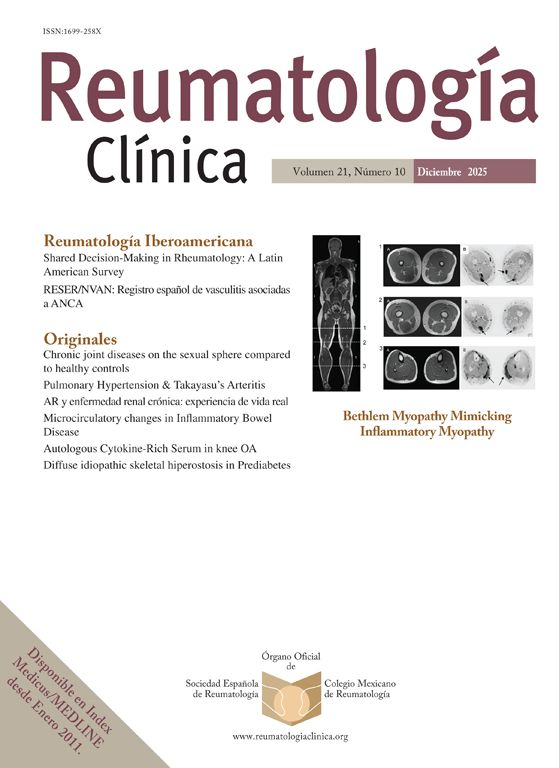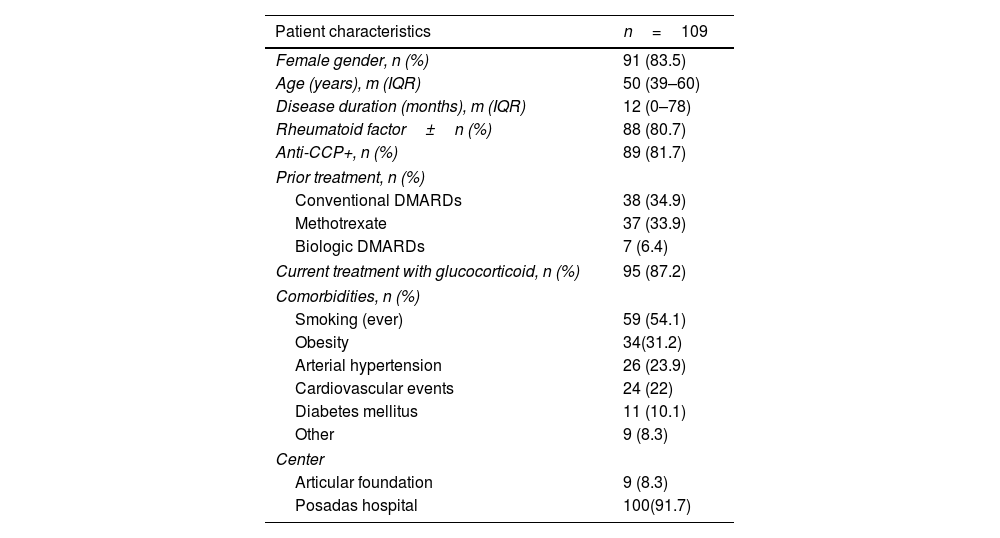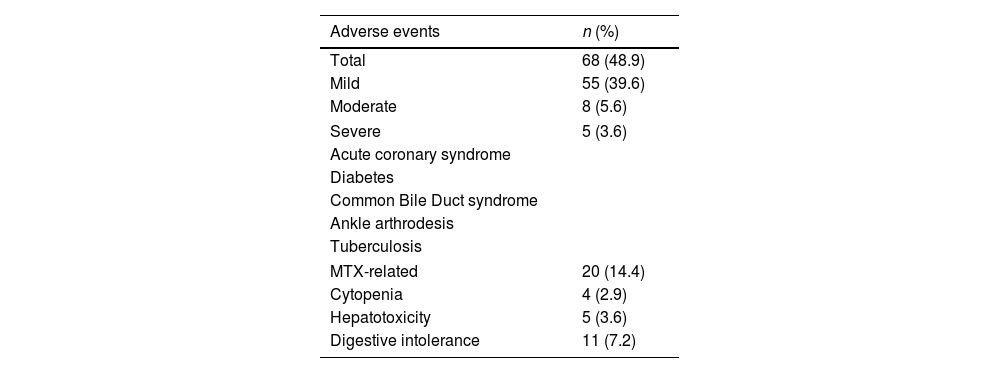To correlate ΔRDW and ΔVCM (baseline and week 12) with the number of patients achieving remission or low disease activity by CDAI at week 24 after initiating MTX.
Materials and methodsRetro-prospective, analytical, and observational study in consecutive adult patients diagnosed with RA (ACR/EULAR 2010). Demographic data, clinical characteristics, personal history, initiated treatments, and VCM (fL) and RDW (%) at weeks 0, 4, 12, and 24 were evaluated. Safety data was recorded. Statistical analysis: descriptive analysis, Chi2 test or Fisher's exact test; Student's T-test or Mann–Whitney; and ANOVA or Kruskal–Wallis. Lineal and/or multiple logistic regression.
Results139 patients were included, of whom 109 completed the study requirements. 83.5% were women, median age (m) 50 years (IQR 39–60), with a median disease duration of 12 months (IQR 0–78). In the per-protocol analysis of 109 patients, the m ΔRDW between baseline and week 12 was 0.8 (IQR 0–2.4), and the m ΔVCM was 2.0 (IQR 0.1–4.4). No correlation was found between ΔRDW and CDAI at week 24 (Rho=−0.08; p=0.416), but a statistically significant correlation was found between ΔVCM and CDAI at week 24 (Rho=−0.190; p=0.048).
Results were analyzed by intention to treat for 139 patients. Between baseline and week 12, a m ΔRDW of 0.8 (IQR 0–2.4) and a m ΔVCM of 2.2 (IQR 0.2–4.5) were recorded. No correlation was found between ΔRDW and CDAI at week 24 (Rho=−0.073; p=0.433), but a statistically significant correlation was found between ΔVCM and CDAI at week 24 (Rho=−0.217; p=0.018). 64.2%, 39.4%, and 15.6% of patients achieved CDAI 50/70/85 responses at week 12, respectively, with no significant changes at week 24. Univariate and multivariate analysis identified that the only factor significantly associated with achieving CDAI 50 at week 24 was achieving such a response at week 12 (p=0.001).
Safety evaluation showed that 68 patients (48.9%) experienced adverse events, with 20 events (14.4%) related to MTX. Only 5 (3.6%) were considered serious adverse events, all of them unrelated to treatment.
ConclusionsThis study revealed that an increase in red cell distribution width (RDW) and mean corpuscular volume (VCM) was associated with the initiation of MTX treatment. However, only a significant correlation was found between the change in VCM and RA activity measured by CDAI at week 24. Although ΔRDW did not show a significant association with RA activity, ΔVCM negatively correlated with CDAI at week 24. Additionally, a significant percentage of patients achieved a positive response at week 12, but there were no significant changes at week 24. Safety analysis showed that some patients experienced adverse events, with a small proportion considered serious adverse events not related to treatment. Overall, these findings suggest the importance of monitoring changes in VCM and considering its relationship with RA activity during MTX treatment.
Correlacionar el ΔRDW y el ΔVCM (línea basal y semana12) con la cantidad de pacientes que alcanzan remisión o baja actividad de la enfermedad según CDAI en la semana24 luego de iniciar tratamiento con metotrexato (MTX).
Materiales y métodosEstudio retrospectivo, analítico y observacional en pacientes adultos consecutivos diagnosticados con artritis reumatoide (AR) (ACR/EULAR 2010). Se evaluaron datos demográficos, características clínicas, antecedentes personales, tratamientos iniciados, y VCM (fL) y RDW (%) en las semanas 0, 4, 12, y 24. Se registraron datos de seguridad. Análisis estadístico: análisis descriptivo, test de chi cuadrado o test exacto de Fisher; test t de Student o Mann-Whitney, y ANOVA o Kruskal-Wallis. Regresión logística lineal y/o múltiple.
ResultadosSe incluyeron 139 pacientes, de los cuales 109 completaron los requisitos del estudio. El 83,5% eran mujeres, edad mediana (m) 50años (IQR: 39-60), con una duración mediana de la enfermedad de 12meses (IQR: 0-78). En el análisis por protocolo de 109 pacientes, el m ΔRDW entre la línea basal y la semana12 fue de 0,8 (IQR: 0-2,4), y el m ΔVCM fue de 2,0 (IQR: 0,1-4,4). No se encontró correlación entre ΔRDW y CDAI en la semana24 (Rho=−0,08; p=0,416), pero se encontró una correlación estadísticamente significativa entre ΔVCM y CDAI en la semana24 (Rho=−0,190; p=0,048).
Los resultados fueron analizados por intención de tratar para 139 pacientes. Entre la línea basal y la semana12 se registró un m ΔRDW de 0,8 (IQR: 0-2,4) y un m ΔVCM de 2,2 (IQR: 0,2-4,5). No se encontró correlación entre ΔRDW y CDAI en la semana24 (Rho=−0,073; p=0,433), pero se encontró una correlación estadísticamente significativa entre ΔVCM y CDAI en la semana24 (Rho=−0,217; p=0,018). El 64,2%, el 39,4% y el 15,6% de los pacientes alcanzaron respuestas CDAI 50/70/85 en la semana12, respectivamente, sin cambios significativos en la semana24. El análisis univariado y multivariado identificó que el único factor significativamente asociado con alcanzar CDAI50 en la semana24 fue alcanzar dicha respuesta en la semana12 (p=0,001).
La evaluación de seguridad mostró que 68 pacientes (48,9%) experimentaron eventos adversos, con 20 eventos (14,4%) relacionados con MTX. Solo 5 (3,6%) se consideraron eventos adversos graves, todos no relacionados con el tratamiento.
ConclusionesEste estudio reveló que un aumento en la amplitud de distribución de los eritrocitos (RDW) y el volumen corpuscular medio (VCM) se asoció con el inicio del tratamiento con MTX. Sin embargo, solo se encontró una correlación significativa entre el cambio en VCM y la actividad de la AR medida por CDAI en la semana24. Aunque el ΔRDW no mostró una asociación significativa con la actividad de la AR, el ΔVCM se correlacionó negativamente con el CDAI en la semana24. Además, un porcentaje significativo de pacientes alcanzó una respuesta positiva en la semana12, pero no hubo cambios significativos en la semana24. El análisis de seguridad mostró que algunos pacientes experimentaron eventos adversos, con una pequeña proporción considerada eventos adversos graves no relacionados con el tratamiento. En general, estos hallazgos sugieren la importancia de monitorear los cambios en VCM y considerar su relación con la actividad de la AR durante el tratamiento con MTX.
Rheumatoid arthritis (RA) is an autoimmune disease with significant joint and systemic involvement, leading to increased morbidity and mortality1. Current therapy emphasizes the “treat to target” strategy, aiming for disease remission or low activity to minimize joint damage.2 Methotrexate (MTX) stands as the primary disease-modifying drug, achieving therapeutic goals in 25–40% of patients within the initial months.3,4 However, predicting which patients will respond to MTX remains elusive, subjecting them to potentially ineffective therapies.
In 2015, the concept of precision medicine emerged, advocating for highly individualized therapeutic strategies. Biomarkers play a crucial role in precision medicine, yet rheumatology has struggled to identify effective predictive biomarkers.5
Patients with RA exhibit an increased red cell distribution width (RDW) compared to controls.6 A retrospective study demonstrated that lower baseline RDW was associated with a higher likelihood of achieving a positive response to MTX at 3 months.7-14 Another hematimetric parameter, mean corpuscular volume (MCV), also increases following MTX treatment and a previous study has shown that higher variations in MCV are associated with a higher probability of achieving a positive therapeutic response at 3 months.15
Against this background, this study aims to evaluate if the change in RDW and MCV after 3 months of MTX therapy can be used to predict the clinical outcomes at 6 months.
ObjectivesPrimaryCorrelate ΔRDW and ΔMCV between baseline and week 12 with the number of patients achieving remission or low disease activity measured by CDAI in RA treated with MTX at week 24.
SecondaryDescribe the proportion of patients achieving low activity/remission by CDAI at week 24.
Describe CDAI 50/70/85 responses at weeks 12 and 24.
Evaluate other clinical factors affecting the MTX response.
Characterize the safety and tolerability profile of methotrexate in RA patients at week 24.
Correlate ΔRDW and/or ΔMCV between baseline and week 12 with the number of patients achieving remission or low disease activity measured by DAS28 in rheumatoid arthritis treated with methotrexate at week 24.
Patients and methodsA retro-prospective analytical and observational study was conducted in consecutive adult patients (≥18 years old) diagnosed with RA who met ACR/EULAR 2010 criteria.16 The Inclusion criteria were Absence of MTX treatment in the last 12 weeks prior to baseline; Patients initiating MTX therapy at baseline; and capability of providing informed consent for study participation. Inclusion in the retrospective evaluation required completion of all study procedures. Exclusion criteria included MCV≥100fl at the time of selection; MCV≤80fl at the time of selection; Pregnancy or immediate plans for maternity and/or lactation; Renal (ClCr≤30) or hepatic (Child–Pugh B/C) insufficiency; Intolerance or toxicity to MTX prevents its use; and presence of chronic diseases compromising data quality or posing a risk to the subject during the study.
Demographic data, disease activity (CDAI17-DAS28 PCR18,19), comorbidities, laboratory parameters, and treatment information were evaluated. Safety assessment was performed at multiple time points over 24 weeks. An adverse event (AE) was defined as an unexpected medical problem occurring during treatment with a drug or other therapy. Adverse events can be mild, moderate, or severe. A serious adverse event (SAE) was defined as an adverse event that poses a threat to life, results in death, causes a causes a congenital anomaly, or leaves a permanent sequel. Statistical analyses included descriptive statistics, significance tests, logistic regression, and safety assessments.
ResultsStudy populationA total of 139 patients were enrolled, of which 109 successfully met all study requirements and completed the prescribed treatment.
83.5% of participants were female, with a median age of 50 years (interquartile range, IQR: 39–60), and a median disease duration of 12 months (IQR: 0–78). Additional demographic details and baseline characteristics are presented in Table 1. Baseline median value for RDW was 14.1 (IQR: 13.3–15.4) and for VCM was 87.0fl (IQR: 84.2–91.2).
Patient characteristics.
| Patient characteristics | n=109 |
|---|---|
| Female gender, n (%) | 91 (83.5) |
| Age (years), m (IQR) | 50 (39–60) |
| Disease duration (months), m (IQR) | 12 (0–78) |
| Rheumatoid factor±n (%) | 88 (80.7) |
| Anti-CCP+, n (%) | 89 (81.7) |
| Prior treatment, n (%) | |
| Conventional DMARDs | 38 (34.9) |
| Methotrexate | 37 (33.9) |
| Biologic DMARDs | 7 (6.4) |
| Current treatment with glucocorticoid, n (%) | 95 (87.2) |
| Comorbidities, n (%) | |
| Smoking (ever) | 59 (54.1) |
| Obesity | 34(31.2) |
| Arterial hypertension | 26 (23.9) |
| Cardiovascular events | 24 (22) |
| Diabetes mellitus | 11 (10.1) |
| Other | 9 (8.3) |
| Center | |
| Articular foundation | 9 (8.3) |
| Posadas hospital | 100(91.7) |
RDW and VCM values underwent statistically significant changes between baseline, weeks 4, 12, and 24 (Table 2).
The per-protocol analysis included 109 patients. The median ΔRDW between baseline and week 12 was 0.8 (IQR 0.0–2.4). No correlation was found between delta RDW and CDAI at week 24: the coefficient result was of low magnitude and lacked statistical significance (Rho=−0.079; p=0.416). The median ΔVCM at week 12 was 2.0 (IQR −0.1 to 4.4). The correlation between delta MCV and CDAI at week 24 was of low intensity, negative direction, and statistically significant (Rho=−0.190; p=0.048).
Results were also analyzed by Intention to Treat for 139 patients. Between baseline and week 12, the median ΔRDW was 0.8 (IQR 0–2.4), and no correlation was found between this ΔRDW and CDAI at week 24; the coefficient's magnitude was small and lacked statistical significance (Rho=−0.073; p=0.433). Between baseline and week 12, the median ΔVCM was 2.2 (IQR 0.2–4.5), and the correlation between this ΔVCM and CDAI at week 24 was low intensity, negatively oriented, and statistically significant (Rho=−0.217).
The proportion of patients with CDAI<10 increased from 11.9% at baseline to 62.4% at week 24. 64.2%, 39.4%, and 15.6% of patients achieved CDAI 50/70/85 responses at week 12, respectively, with no significant changes at week 24. Table 3 shows the analysis by protocol and intention to treat for ΔRDW and ΔVCM and CDAI<10 or ≥10 at Week 24.
By protocol and intention to treat analysis.
| Analysis by protocol | |||
|---|---|---|---|
| ΔRDW | |||
| n | m (IQR) | p | |
| CDAI<10W24 | 68 | 0.9 (0.1–2.3) | 0.839 |
| CDAI≥10W24 | 41 | 0.8 (0–3.1) | |
| ΔVCM | |||
|---|---|---|---|
| n | m (IQR) | p | |
| CDAI<10W24 | 68 | 2.6 (0.6–4.4) | 0.109 |
| CDAI≥10W24 | 41 | 1.2 (−0.6–4.7) |
| Analysis by intention to treat | |||
|---|---|---|---|
| ΔRDW | |||
| n | m (IQR) | p | |
| CDAI<10W24 | 72 | 0.9 (0.1–2.3) | 0.869 |
| CDAI≥10W24 | 45 | 0.8 (0–3.1) | |
| ΔVCM | |||
|---|---|---|---|
| n | m (IQR) | p | |
| CDAI<10W24 | 72 | 2.7 (0.6–5.1) | 0.049 |
| CDAI≥10W24 | 46 | 1.2 (−0.3–4.0) |
In the univariate analysis, the only factor significantly associated with achieving a CDAI 50 response at week 24 was having attained such a response at week 12 (p=0.001). Trends were observed, though not reaching statistically significant values, in seronegative and DMARD-naive patients. In the multivariate analysis, considering CDAI 50 response at Week 12, age, gender, comorbidities, and prior treatment as variables, the only significantly associated factor was achieving CDAI 50 response at Week 12.
No correlation was found between ΔRDW at week 12 and DAS28 value at week 24 (Rho=−0.026; p=0.790), nor between ΔVCM at week 12 and DAS28 at week 24 (Rho=−0.094; p=0.337).
A safety assessment revealed that 68 patients (48.9%) had experienced some adverse events. Of these, 20 adverse events (14.4%) were attributed to MTX. Only 5 (3.6%) were considered serious adverse events and were not attributed to the treatment (Table 4).
DiscussionWe found in our study an association between change in mean volume corpuscular width (ΔMCV) in patients with rheumatoid arthritis treated with methotrexate and the clinical disease activity (CDAI) at week 24. However, it is important to note that this relationship exhibits modest intensity, emphasizing the need for further research in this direction to confirm its clinical relevance.
In terms of methotrexate therapy, our findings support its effectiveness, as significant rates of remission were observed in patients throughout the study. Additionally, the safety profile of methotrexate aligns with what has been reported in the scientific literature to date, suggesting that it is a safe and well-tolerated drug for the majority of patients.
A key discovery from our study is that the only clinical variable associated with a positive response at week 24 was achieving remission at week 12. A trend was also noted in treatment-naïve and seronegative patients, which may be relevant for identifying subgroups of patients more likely to respond to methotrexate.
The antifolate effect of methotrexate arises from its structure, similar to folic acid, allowing competitive inhibition of dihydrofolate reductase 12. The inhibitory effects of methotrexate depend on its intracellular concentrations, with tissues exhibiting higher cellular metabolism and faster growth being the most affected. Among these tissues are neoplastic tissues, capillary follicles, epithelial cells of the digestive tract, and bone marrow cells. Therefore, we hypothesized that by altering the folate pathway, hematimetric indices could serve as an indirect estimator of treatment response.
Red Cell Distribution Width (RDW) is a quantitative measure of variability in the size of circulating red blood cells. Higher RDW values indicate greater heterogeneity in red blood cell sizes and are used for the differential diagnosis of various types of anemias. RDW can increase in different inflammatory background diseases and correlate with the level of inflammation, such as in cardiovascular diseases.9–12 Patel et al. demonstrated that the RDW can be used as a predictor of mortality in older adults. For every 1% increase in RDW, the risk of total mortality increased by 14% (HR: 1.14; 95% CI: 1.11–1.17).
On the other hand, mean corpuscular volume (MCV) reflects the average size of red blood cells.6 It is a routine parameter for assessing red blood cells, defining them as normocytic, microcytic, or hypochromic. A study conducted by Shipa and colleagues demonstrated that combined HCQ with MTX therapy was associated with a twofold increase in the probability of response, defined as clinical remission or low disease activity at 6 months. Using latent class mixed models, an MCV increase>5 fl observed in patients with combined treatment was associated with an odds ratio of treatment response of 16.2 compared to those receiving MTX alone, suggesting a significant association with a better treatment response.20 A study demonstrated in patients with psoriatic arthritis that the change in MCV at 12 weeks was the best positive predictor of response at 24 weeks.
Our study makes a significant contribution to the field of rheumatology by suggesting that monitoring ΔMCV at 12 weeks could help predict the response to methotrexate in RA patients, consistent with previous research. The ability to identify patients likely to respond to methotrexate at an early stage of treatment could be crucial to avoid unnecessary exposure to ineffective therapies, potentially improving the quality of life for patients and reducing medical costs in RA treatment. The minimal costs required to measure MCV and RDW and their ample availability in low-income settings make these potential biomarkers especially interesting, as they could be used almost anywhere and not be bound to high-complexity centers.
However, it is important to emphasize that further research is required to validate and expand these findings, as well as to develop more precise biomarkers for the effective identification of patients who will respond favorably to methotrexate in the treatment of rheumatoid arthritis. Additionally, the importance of expanding the study in a multicenter manner to favor its external validity and increasing the representativeness of other populations is highlighted.
Authors’ contributionsAll authors contributed substantially to the conception and design of the work, as well as the acquisition and interpretation of data. FS, RG, and RGS additionally analyzed the data and drafted the initial version of the manuscript. The final manuscript has been critically reviewed and approved by all authors, who have paid attention to ensuring the integrity of the work.
Ethical approvalThis observational study was approved by an institutional ethics committee and conducted in accordance with the current Declaration of Helsinki on local health ministry resolution 1480/11, and applicable local regulations for this type of study. Patient confidentiality was respected according to local law, and informed consent for publication was obtained.
Consent to publishThe final manuscript has been seen and approved by all authors, who have paid attention to ensuring the integrity of the work.
Conflict of interestThe authors declare no conflicts of interest.










